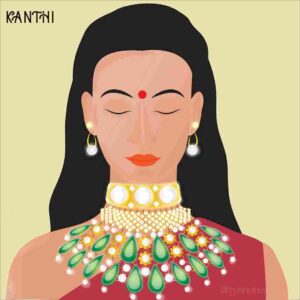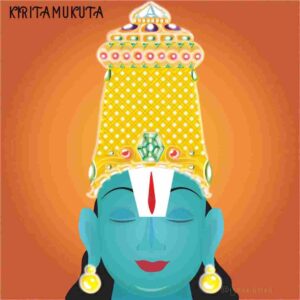Indian Jewellery: Ten iconic ornaments from classical India – Part Two

In this series, we showcase a curated set of ten classical Indian jewelled ornaments in the #theartofadornment. This is a continuation of the Part One – don’t miss it. And now, we continue!
Kanthi

Many contemporary fashion magazines claim that choker necklaces first appeared in France in the 18th century, when female French expatriates wore red ribbons around their necks as a way of paying tribute to those who had lost their lives to the guillotine. But have they heard of the Kanthi?
A Kanthi is a choker neckalce, or a type of collared necklet that is very tightly worn around the neck. Neck ornaments can broadly be classified as Haras and Kanthi. Haras are the longer neckalces, while kanthis are the collared necklaces.
Kanthis made of gold were quite popular in the Mauryan and Gupta eras, while the ones with beads were popular in the Sarasvati Valley Civilisation. Sculptures of Nagarjunakonda also perfectly depict women using kanthis. This tradition goes a long way back in India. Go, tell them!
Skandamala and Kanidaka

Classical Indian jewellery really goes up a notch with Skandamala and Kanidaka – adorning the shoulder and the neck respectively! The Skandamala is a garland for shoulders, usually made of either beads or gold. Kanidaka is a necklace made of beads, seen loosely falling over either arm.
Deities such as Lord Shiva, Karthikeya, Spatamatrika and Vinayaka are depicted wearing skandamalas on both shoulders. Many Pallavan and Pandyan sculptures depict several forms of Shiva adorned with elaborate skandamalas.
With historical references tracing back to Jakata sculptures, Kanidakas were quite popular during the Mauryan era as a common ornament worn by both men and women. There are also references to these ornaments in Nagarjunakonda sculptures.
KiritiMukuta

Kiritāmukutā translates to glory head jewel (kirita-glory, mukuta-head jewel).
It is a conical or cylindrical crown with embellishments. Kiritāmukutā is a symbol for royalty, and is usually presented to Kings/Emperors during their coronation – the highest of all the crowns literally and metaphorically.
Lord Narayana is usually seen to be wearing a kiritāmukutā on his head. Many of the Vaishnavan sculptures, temples and shrines portray Narayana/Vishnu carrying a kiritāmukutā with his status as ‘the greatest of all’, the ones at Sri Venkateshwara temple in Tirupathi, and Sri Ranganatha Swamy temple in Sri Rangam being particularly impressive.
A variation of kiritāmukutā , called karandāmukutā (karanda-bowl shaped vessel) is usually adorned by female deities and other gods. Some of the historical references trace back to Adi Varaha caves, where sculptures show many of the Pallavan dynasty rulers adorning their heads with kiritāmukutā as a symbol of royal superiority.
Vaijanthi Mala

Vaijayanti Mala or Vanamala is a garland made of vaijayanthi flowers – these are wild and unfading flowers very dear to Lord Vishnu.
Vaijayanthi Mala is considered to be a living feminine entity representing the absolute super controllership of a civilization; during Samudra-Manthan when Goddess Lakshmi emerges from the ocean of milk, she chooses Vishnu as her husband and adorns him with a Vaijayanthimala – a garland ritual that continues to this day in Hindu weddings, albeit with different flower combinations.
One of the thousand names of Vishnu includes Vanamali – one who wears the vanamala (garland made of forest flowers).
Bonus: Makarakundala

Makarakundala or Crocodile ear-ornaments because we can’t have enough of these beauties!
So there you have it – a cursory glance into classical Indian jewellery that illustrates the art of adornment so well known in Indian civilisation. The temples of South India, Bengal, Odisha and Central India present a veritable cornucopia of the jeweller’s art – the next time you visit an Indian temple complex – try to look out for these tantalising objects!
Follow Ishva.co on Instagram for more cultural inspiration, every day of the week. We’re a lot more busy on there!
